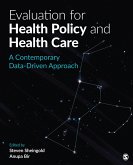David E Grembowski
The Practice of Health Program Evaluation
David E Grembowski
The Practice of Health Program Evaluation
- Broschiertes Buch
- Merkliste
- Auf die Merkliste
- Bewerten Bewerten
- Teilen
- Produkt teilen
- Produkterinnerung
- Produkterinnerung
Reflecting the latest developments in the field, The Practice of Health Program Evaluation, Second Edition provides readers with effective methods for evaluating health programs and offers expert guidance for collaborating with stakeholders involved in the process. Author David Grembowski explores evaluation as a three-act play: Act I shows evaluators how to work with decision makers and other groups to identify the questions they want answered; Act II covers selecting appropriate evaluation designs to reveal insight about the program's impacts, cost-effectiveness, and implementation; and Act…mehr
Andere Kunden interessierten sich auch für
![Conducting Health Research Conducting Health Research]() Frederick J KvizConducting Health Research199,99 €
Frederick J KvizConducting Health Research199,99 €![Evidence-Based Public Health Practice Evidence-Based Public Health Practice]() Arlene G FinkEvidence-Based Public Health Practice115,99 €
Arlene G FinkEvidence-Based Public Health Practice115,99 €![Evaluation for Health Policy and Health Care Evaluation for Health Policy and Health Care]() Evaluation for Health Policy and Health Care199,99 €
Evaluation for Health Policy and Health Care199,99 €![Collaborative Approaches to Evaluation Collaborative Approaches to Evaluation]() Collaborative Approaches to Evaluation51,99 €
Collaborative Approaches to Evaluation51,99 €![Researching Health Together Researching Health Together]() Researching Health Together170,99 €
Researching Health Together170,99 €![Intermediate Statistics Using SPSS Intermediate Statistics Using SPSS]() Herschel KnappIntermediate Statistics Using SPSS170,99 €
Herschel KnappIntermediate Statistics Using SPSS170,99 €![Health Promotion in Multicultural Populations Health Promotion in Multicultural Populations]() Health Promotion in Multicultural Populations199,99 €
Health Promotion in Multicultural Populations199,99 €-
-
-
Reflecting the latest developments in the field, The Practice of Health Program Evaluation, Second Edition provides readers with effective methods for evaluating health programs and offers expert guidance for collaborating with stakeholders involved in the process. Author David Grembowski explores evaluation as a three-act play: Act I shows evaluators how to work with decision makers and other groups to identify the questions they want answered; Act II covers selecting appropriate evaluation designs to reveal insight about the program's impacts, cost-effectiveness, and implementation; and Act III discusses making use of the findings. Packed with relevant examples and detailed explanations, the book fully prepares readers to apply research methods in the practice of health program evaluation.
Hinweis: Dieser Artikel kann nur an eine deutsche Lieferadresse ausgeliefert werden.
Hinweis: Dieser Artikel kann nur an eine deutsche Lieferadresse ausgeliefert werden.
Produktdetails
- Produktdetails
- Verlag: Sage Publications
- 2nd edition
- Seitenzahl: 352
- Erscheinungstermin: 22. Oktober 2015
- Englisch
- Abmessung: 233mm x 187mm x 22mm
- Gewicht: 589g
- ISBN-13: 9781483376370
- ISBN-10: 1483376370
- Artikelnr.: 42697840
- Herstellerkennzeichnung
- Libri GmbH
- Europaallee 1
- 36244 Bad Hersfeld
- gpsr@libri.de
- Verlag: Sage Publications
- 2nd edition
- Seitenzahl: 352
- Erscheinungstermin: 22. Oktober 2015
- Englisch
- Abmessung: 233mm x 187mm x 22mm
- Gewicht: 589g
- ISBN-13: 9781483376370
- ISBN-10: 1483376370
- Artikelnr.: 42697840
- Herstellerkennzeichnung
- Libri GmbH
- Europaallee 1
- 36244 Bad Hersfeld
- gpsr@libri.de
David Grembowski, Ph.D., M.A., is a professor in the Department of Health Ser- vices in the School of Public Health and the Department of Oral Health Sciences in the School of Dentistry, and adjunct professor in the Department of Sociology, at the University of Washington. He has taught health program evaluation to graduate students for more than twenty years. His evaluation interests are prevention, the performance of health programs and health care systems, survey research methods, and the social determinants of population health. His other work has examined efforts to improve quality by increasing access to care in integrated delivery systems; pharmacy outreach to provide statins preventively to patients with diabetes; managed care and physician referrals; managed care and patient-physician relationships and physician job satisfaction; cost-effectiveness of preventive services for older adults; cost-sharing and seeing out-of-network physicians; social gradients in oral health; local health department spending and racial/ethnic disparities in mortality rates; fluoridation effects on oral health and dental demand; financial incentives and dentist adoption of preventive technologies; effects of dental insurance on dental demand; and the link between mother and child access to dental care.
1. Health Program Evaluation: Is It Worth It?
Growth of Health Program Evaluation
Types of Health Program Evaluation
Summary
List of Terms
Study Questions
2. The Evaluation Process as a Three-Act Play
Evaluation as a Three-Act Play
Role of the Evaluator
Evaluation in a Cultural Context
Ethical Issues
Evaluation Standards
Summary
List of Terms
Study Questions
Act I: Asking the Question
3. Developing Evaluation Questions
Step 1: Specify Program Theory
Step 2: Specify Program Objectives
Step 3: Translate Program Theory and Objectives Into Evaluation Questions
Step 4: Select Key Questions
Assessment of Fit
Summary
List of Terms
Study Questions
Act II: Answering the Question; Scene 1: Developing the Evaluation Design
to Answer the Questions
4. Evaluation of Program Impacts
Quasi-Experimental Study Designs
Counterfactuals and Experimental Study Designs
Statistical Threats to Validity
Generalizability of Impact Evaluation Results
Evaluation of Impact Designs and Meta-Analysis
Summary
List of Terms
Study Questions
5. Cost-Effectiveness Analysis
Cost-Effectiveness Analysis: An Aid to Decision Making
Comparing Program Costs and Effects: The Cost-Effectiveness Ratio
Types of Cost-Effectiveness Analysis
Steps in Conducting a Cost-Effectiveness Analysis
Evaluation of Program Effects and Costs
Summary
List of Terms
Study Questions
6. Evaluation of Program Implementation
Types of Evaluation Designs for Answering Implementation Questions
Types of Implementation Questions and Designs for Answering Them
Summary
List of Terms
Study Questions
Act II: Answering the Question; Scenes 2 and 3: Developing the Methods to
Carry Out the Design and Conducting the Evaluation
7. Population and Sampling
Step 1: Identify the Target Populations of the Evaluation
Step 2: Identify the Eligible Members of Each Target Population
Step 3: Decide Whether Probability of Nonprobability Sampling is Necessary
Step 4: Choose a Nonprobability Sampling Design for Answering an Evaluation
Question
Step 5: Choose a Probability Sampling Design Answering an Evaluation
Question
Step 6: Determine Minimum Sample Size Requirements
Step 7: Select the Sample
Summary
List of Terms
Study Questions
8. Measurement and Data Collection
Measurement and Data Collection in Quantitative Evaluations
Data Collection in Qualitative Evaluations
Reliability and Validity in Qualitative Evaluations
Management of Data Collection
Summary
Resources
List of Terms
Study Questions
9. Data Analysis
Introduction
Getting Started: What¿s the Question?
Qualitative Data Analysis
Quantitative Data Analysis
Summary
List of Terms
Study Questions
Act III: Using the Answers in Decision Making
10. Disseminating the Answers to Evaluation Questions
Scene 1: Translating Evaluation Answers Back Into Policy Language
Scene 2: Developing a Dissemination Plan for Evaluation Answers
Scene 3: Using the Answers in Decision Making and the Policy Cycle
How Answers Are Used by Decision Makers
Summary
List of Terms
Study Questions
11. Epilogue
Growth of Health Program Evaluation
Types of Health Program Evaluation
Summary
List of Terms
Study Questions
2. The Evaluation Process as a Three-Act Play
Evaluation as a Three-Act Play
Role of the Evaluator
Evaluation in a Cultural Context
Ethical Issues
Evaluation Standards
Summary
List of Terms
Study Questions
Act I: Asking the Question
3. Developing Evaluation Questions
Step 1: Specify Program Theory
Step 2: Specify Program Objectives
Step 3: Translate Program Theory and Objectives Into Evaluation Questions
Step 4: Select Key Questions
Assessment of Fit
Summary
List of Terms
Study Questions
Act II: Answering the Question; Scene 1: Developing the Evaluation Design
to Answer the Questions
4. Evaluation of Program Impacts
Quasi-Experimental Study Designs
Counterfactuals and Experimental Study Designs
Statistical Threats to Validity
Generalizability of Impact Evaluation Results
Evaluation of Impact Designs and Meta-Analysis
Summary
List of Terms
Study Questions
5. Cost-Effectiveness Analysis
Cost-Effectiveness Analysis: An Aid to Decision Making
Comparing Program Costs and Effects: The Cost-Effectiveness Ratio
Types of Cost-Effectiveness Analysis
Steps in Conducting a Cost-Effectiveness Analysis
Evaluation of Program Effects and Costs
Summary
List of Terms
Study Questions
6. Evaluation of Program Implementation
Types of Evaluation Designs for Answering Implementation Questions
Types of Implementation Questions and Designs for Answering Them
Summary
List of Terms
Study Questions
Act II: Answering the Question; Scenes 2 and 3: Developing the Methods to
Carry Out the Design and Conducting the Evaluation
7. Population and Sampling
Step 1: Identify the Target Populations of the Evaluation
Step 2: Identify the Eligible Members of Each Target Population
Step 3: Decide Whether Probability of Nonprobability Sampling is Necessary
Step 4: Choose a Nonprobability Sampling Design for Answering an Evaluation
Question
Step 5: Choose a Probability Sampling Design Answering an Evaluation
Question
Step 6: Determine Minimum Sample Size Requirements
Step 7: Select the Sample
Summary
List of Terms
Study Questions
8. Measurement and Data Collection
Measurement and Data Collection in Quantitative Evaluations
Data Collection in Qualitative Evaluations
Reliability and Validity in Qualitative Evaluations
Management of Data Collection
Summary
Resources
List of Terms
Study Questions
9. Data Analysis
Introduction
Getting Started: What¿s the Question?
Qualitative Data Analysis
Quantitative Data Analysis
Summary
List of Terms
Study Questions
Act III: Using the Answers in Decision Making
10. Disseminating the Answers to Evaluation Questions
Scene 1: Translating Evaluation Answers Back Into Policy Language
Scene 2: Developing a Dissemination Plan for Evaluation Answers
Scene 3: Using the Answers in Decision Making and the Policy Cycle
How Answers Are Used by Decision Makers
Summary
List of Terms
Study Questions
11. Epilogue
1. Health Program Evaluation: Is It Worth It?
Growth of Health Program Evaluation
Types of Health Program Evaluation
Summary
List of Terms
Study Questions
2. The Evaluation Process as a Three-Act Play
Evaluation as a Three-Act Play
Role of the Evaluator
Evaluation in a Cultural Context
Ethical Issues
Evaluation Standards
Summary
List of Terms
Study Questions
Act I: Asking the Question
3. Developing Evaluation Questions
Step 1: Specify Program Theory
Step 2: Specify Program Objectives
Step 3: Translate Program Theory and Objectives Into Evaluation Questions
Step 4: Select Key Questions
Assessment of Fit
Summary
List of Terms
Study Questions
Act II: Answering the Question; Scene 1: Developing the Evaluation Design
to Answer the Questions
4. Evaluation of Program Impacts
Quasi-Experimental Study Designs
Counterfactuals and Experimental Study Designs
Statistical Threats to Validity
Generalizability of Impact Evaluation Results
Evaluation of Impact Designs and Meta-Analysis
Summary
List of Terms
Study Questions
5. Cost-Effectiveness Analysis
Cost-Effectiveness Analysis: An Aid to Decision Making
Comparing Program Costs and Effects: The Cost-Effectiveness Ratio
Types of Cost-Effectiveness Analysis
Steps in Conducting a Cost-Effectiveness Analysis
Evaluation of Program Effects and Costs
Summary
List of Terms
Study Questions
6. Evaluation of Program Implementation
Types of Evaluation Designs for Answering Implementation Questions
Types of Implementation Questions and Designs for Answering Them
Summary
List of Terms
Study Questions
Act II: Answering the Question; Scenes 2 and 3: Developing the Methods to
Carry Out the Design and Conducting the Evaluation
7. Population and Sampling
Step 1: Identify the Target Populations of the Evaluation
Step 2: Identify the Eligible Members of Each Target Population
Step 3: Decide Whether Probability of Nonprobability Sampling is Necessary
Step 4: Choose a Nonprobability Sampling Design for Answering an Evaluation
Question
Step 5: Choose a Probability Sampling Design Answering an Evaluation
Question
Step 6: Determine Minimum Sample Size Requirements
Step 7: Select the Sample
Summary
List of Terms
Study Questions
8. Measurement and Data Collection
Measurement and Data Collection in Quantitative Evaluations
Data Collection in Qualitative Evaluations
Reliability and Validity in Qualitative Evaluations
Management of Data Collection
Summary
Resources
List of Terms
Study Questions
9. Data Analysis
Introduction
Getting Started: What¿s the Question?
Qualitative Data Analysis
Quantitative Data Analysis
Summary
List of Terms
Study Questions
Act III: Using the Answers in Decision Making
10. Disseminating the Answers to Evaluation Questions
Scene 1: Translating Evaluation Answers Back Into Policy Language
Scene 2: Developing a Dissemination Plan for Evaluation Answers
Scene 3: Using the Answers in Decision Making and the Policy Cycle
How Answers Are Used by Decision Makers
Summary
List of Terms
Study Questions
11. Epilogue
Growth of Health Program Evaluation
Types of Health Program Evaluation
Summary
List of Terms
Study Questions
2. The Evaluation Process as a Three-Act Play
Evaluation as a Three-Act Play
Role of the Evaluator
Evaluation in a Cultural Context
Ethical Issues
Evaluation Standards
Summary
List of Terms
Study Questions
Act I: Asking the Question
3. Developing Evaluation Questions
Step 1: Specify Program Theory
Step 2: Specify Program Objectives
Step 3: Translate Program Theory and Objectives Into Evaluation Questions
Step 4: Select Key Questions
Assessment of Fit
Summary
List of Terms
Study Questions
Act II: Answering the Question; Scene 1: Developing the Evaluation Design
to Answer the Questions
4. Evaluation of Program Impacts
Quasi-Experimental Study Designs
Counterfactuals and Experimental Study Designs
Statistical Threats to Validity
Generalizability of Impact Evaluation Results
Evaluation of Impact Designs and Meta-Analysis
Summary
List of Terms
Study Questions
5. Cost-Effectiveness Analysis
Cost-Effectiveness Analysis: An Aid to Decision Making
Comparing Program Costs and Effects: The Cost-Effectiveness Ratio
Types of Cost-Effectiveness Analysis
Steps in Conducting a Cost-Effectiveness Analysis
Evaluation of Program Effects and Costs
Summary
List of Terms
Study Questions
6. Evaluation of Program Implementation
Types of Evaluation Designs for Answering Implementation Questions
Types of Implementation Questions and Designs for Answering Them
Summary
List of Terms
Study Questions
Act II: Answering the Question; Scenes 2 and 3: Developing the Methods to
Carry Out the Design and Conducting the Evaluation
7. Population and Sampling
Step 1: Identify the Target Populations of the Evaluation
Step 2: Identify the Eligible Members of Each Target Population
Step 3: Decide Whether Probability of Nonprobability Sampling is Necessary
Step 4: Choose a Nonprobability Sampling Design for Answering an Evaluation
Question
Step 5: Choose a Probability Sampling Design Answering an Evaluation
Question
Step 6: Determine Minimum Sample Size Requirements
Step 7: Select the Sample
Summary
List of Terms
Study Questions
8. Measurement and Data Collection
Measurement and Data Collection in Quantitative Evaluations
Data Collection in Qualitative Evaluations
Reliability and Validity in Qualitative Evaluations
Management of Data Collection
Summary
Resources
List of Terms
Study Questions
9. Data Analysis
Introduction
Getting Started: What¿s the Question?
Qualitative Data Analysis
Quantitative Data Analysis
Summary
List of Terms
Study Questions
Act III: Using the Answers in Decision Making
10. Disseminating the Answers to Evaluation Questions
Scene 1: Translating Evaluation Answers Back Into Policy Language
Scene 2: Developing a Dissemination Plan for Evaluation Answers
Scene 3: Using the Answers in Decision Making and the Policy Cycle
How Answers Are Used by Decision Makers
Summary
List of Terms
Study Questions
11. Epilogue








